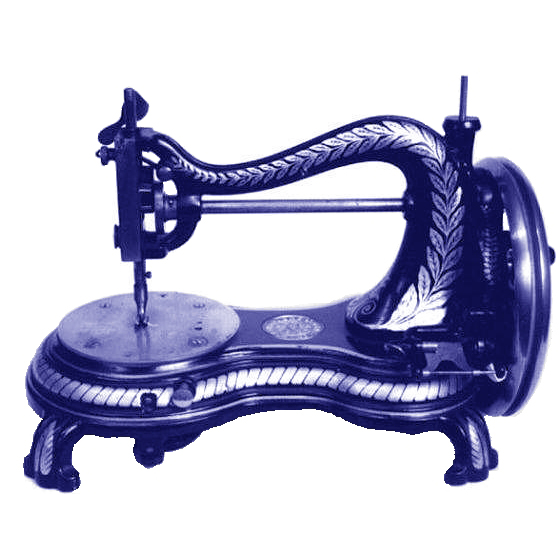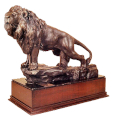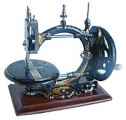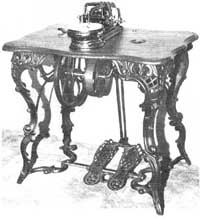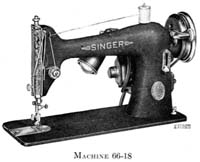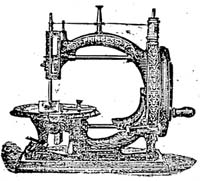An Old Lady is Reborn
ONE DAY last summer Graham was on one of his rare visits to Leicester, looking at a selection of old sewing machines collected over the past 10 years and stored in my factory, upstairs and out of the way.
There was not an awful lot to enthuse about. Most of them were very dirty, covered in grime of the years gone by, and some seriously immobilised by persons unknown.
Some 20 minutes later he suddenly darted forward his eyes bright with interest, grabbing at a particularly-terrible specimen and proudly declared that here was a very rare machine. So rare that he had never seen one before, only read about it in his archives.
There, on the very ornate base with rampant horses, was the name England's Queen. On closer inspection we discovered that several parts were missing whilst others were broken. "Shame about that", said Graham, and after more cups of tea he finally left, leaving me to ponder about this rare find.
Over the next few weeks I made further enquiries with Bernard Williams and Martin Gregory who were very helpful, both of them endorsing what Graham had said. Martin was able to come to my aid with a very old Patent Specification dated 1871 taken out by Newton Wilson describing in very hazy terms his wonder machine that could zigzag, embroider, buttonhole, etc, but all very vague with options on how this wondrous sewing would be achieved.
I quickly realised that all the main components, except the feed bar, were present on the machine that I had, so refurbishment would be possible.
The first problem was to repair the complicated shuttle drive which was broken in two and I only had one of the pieces. I drew out the shape I thought it must be and several days later, with a bit of welding and machining, I had a part that worked, and so on to the next problem, the missing feed bar.
By now I had stripped the machine completely and started to repaint. It must have been at this stage that I suddenly realised how similar this machine was to the Princess of Wales machine, also by Newton Wilson . On closer examination I discovered that most of the main parts were identical and would interchange, a fact that, had I realised it earlier, would have saved me an awful lot of work.
The good fortune I had, apart from discovering the machine in the first place, was that all the parts that made the machine zigzag were present on the machine leaving the only problem, the feed bar, which was specific to the England's Queen and would have to be made from the brief information on the patent specification.
By this time I was getting quite excited as I now knew that it was only a matter of time and effort and I would be able to get it to work. I had real problems with the feed bar as this had to operate in a double-track cross-over cam which, try as I might, would continually jam at the point of the crossover.
This was finally overcome by altering the fixed peg shape into a floating shoe which worked very well and enabled me to finally get the machine to sew either straight line or zigzag.
One has to wonder why this machine, made by a British manufacturer, has taken so long to surface. Had a batch of them been made, surely, with all the collectors looking for old machines, we should have seen this model before now.
I personally think that the answer lays in the patent specification which, when you read it, it is apparent that three options are given to arrive at the same result. The patent specification shows pro-vision for adjusting the zig zag but there is no machinism for this on the machine I have.
So, unless further machines are discovered later, I think we must assume that perhaps, as the design is so crude, it was decided not to produce any more, other than this machine as a sample model, in which case it is very lucky to have survived with nearly all the relevant parts intact.
The painting went quite well. Graham told me that these machines had a lot of gold on them so I have lavished 24-carat gold leaf heavily on the base.
The result is a very bright-looking machine, obviously restored, but I think very pleasing to the eye, and it works really well as you will see at the Convention.
Les Gent
